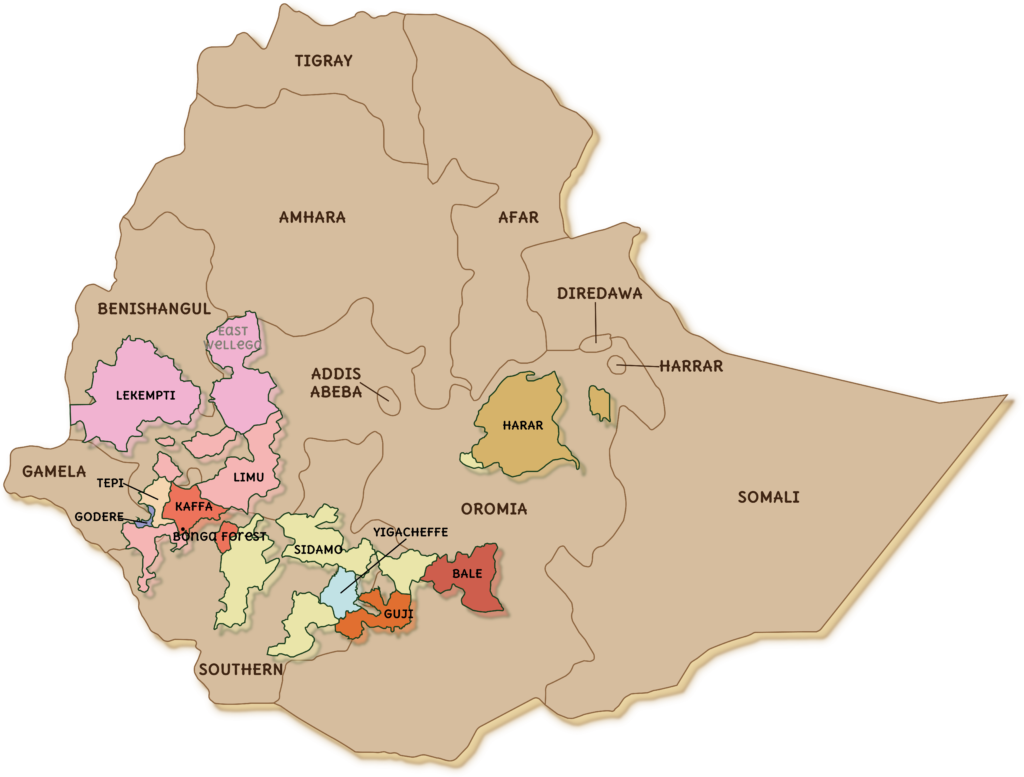Info
Menu
Kontakt
Adresse:
ENKU COFFEE EXPORT PLC
Kirkos Sub City, Woreda 8, Hous NO. 605
Addis Ababa, Ethiopia
Tel.:
Phone: +251 911 523972
E-Mail:
coffeeenku@gmail.com
Ethiopia’s significant coffee production stems from a diverse range of favorable conditions, including a favorable environment and minimal disease and pest pressures. Remarkably, Ethiopia possesses a unique advantage as the sole country naturally gifted to produce specialty coffee. The reasons for this exceptional status are manifold:
The cultivation of coffee in Ethiopia is classified into four categories: forest coffee (10%), semi-forest coffee (35%), garden coffee (50%), and modern coffee plantations (5%), collectively contributing to the country’s coffee production. The majority, over 90%, of coffee is grown by smallholder farmers, reflecting the strong community involvement in the industry. With 1.2 million hectares of land dedicated to coffee production, approximately 900,000 hectares are estimated to be actively productive, illustrating the substantial scale of Ethiopia’s coffee-growing endeavors.

Limu
sweet and complex coffee with a winey, nutty flavour
Yirgacheffe
bright coffee with a light body with complex fruity and floral notes
Harar
rich body with a deep mocca flavour, winey notes and a creamy aftertaste
Tepi
rich body with light acidity and almond, nutty flavours
Bench Maji
coffee with deep winey, floral notes and a rich body
Sidama
spicy and chocolatey coffee with medium acidity
Guji
light body with citric fruit and floral notes such as jasmine and peach
Forest coffee refers to wild types of coffee grown in the montane rainforests of Ethiopia with minimal human interference. Here, the coffee types are genetically heterogeneous, offering a wide diversity for selection and breeding, and are grown under a canopy of trees. In comparison to the other production systems, productivity in forests is low due to little light. 8 areas are registered as forest coffee producers, 3 of which are registered by UNESCO.


In semi-forests, coffee grows in forests that have been deliberately modified. This means that the tree crowns are cut back to allow more light to reach the coffee and thus increase yields. In addition, trees with a large canopy are preferred so that fewer trees are needed for coffee production.
In gardens, coffee is planted with locals seedlings and are planted amongst other crops in a multicultural garden. Due to the high maintenance of weed control, organic fertilizers and shade levels, the productivity of garden coffee is much higher in comparison to forest coffee.


In Ethiopia, the few plantations that exist are generally owned by private farms and the state. Such farms practice pruning, fertilizing, as well as management over weed, pest, shade and plant density. Additionally, they are controlled by ecological conservation principles, hence, they embrace the basic characteristics of agro-ecological sustainability.
Adresse:
ENKU COFFEE EXPORT PLC
Kirkos Sub City, Woreda 8, Hous NO. 605
Addis Ababa, Ethiopia
Tel.:
Phone: +251 911 523972
E-Mail:
coffeeenku@gmail.com